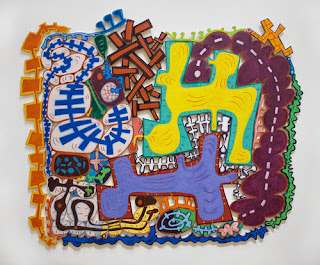Artist: Kerstin Bratsch
Title: Blocked Radiant C
Date: 2011
Medium: Oil on paper
Dimensions: 110 x 72"
This caught my eye because its combining and layering various ideas and shapes and colours into one painting, which is what I'm hoping to do with my narrative. I especially like the orange and occasionally blue highlights on the black figures.
Artist: R. H. Quaytman
Title: iamb (The Limbo of Vanity)
Date: 2008
Medium: Oil, Silkscreen ink, Gesso on wood
Dimensions: 32 3/8 x 52 3/8"
I like this piece of art because it also uses layering and various mediums to create a whole. It's pretty and interesting to look at, yet it's simple. It also demonstrates that you don't need a bunch of colours to create a powerful painting.
Artist: Elizabeth Murray
Title: Do the Dance
Date: 2005
Medium: Oil on canvas on wood
Dimensions: 9' 5" x 11' 3"
I really like this piece of art because of the bold shapes and colours. It's using an almost cartoon-like style to deliver a message, which I think is a really interesting idea.











